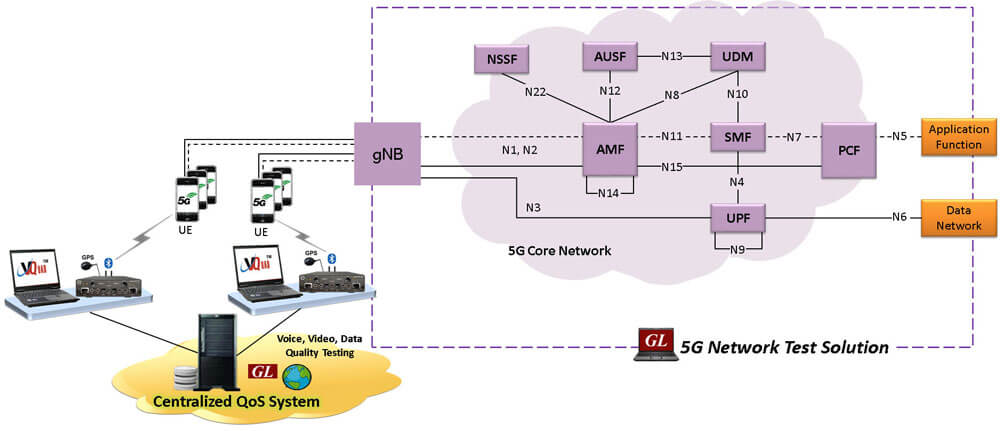GL Announces 5G Test Solutions
Welcome to another issue of GL's Newsletter providing information and insight into our latest 5G Network Test solutions! The solutions are categorized into:
- 5G Core Network Testing: GL can simulate the multitude of 5G Core network elements such as the UE+gNB, AMF, SMF, UPF, AUSF, UDM, UDR, NSSF, and NRF
- 5G Voice and Data Quality Testing: GL can measure voice quality, latency, and throughput across all wireless networks including 5G by directly connecting to endpoint devices such as cell phones and sending and recording audio files

Figure: Testing the 5G Core Network
Overview
GL Communications has developed the MAPS™ (Message Automation and Protocol Simulation) software simulation suite. This versatile software program can emulate a multitude of different protocols spanning the Time-Domain Multiplexing (CAS, SS7, ISDN, etc.), Voice over IP (SIP, RTP, SIGTRAN, etc.), and Wireless (2G, 3G, 4G LTE, 5G) domains.
As depicted in the figure above, the End-to-End 5G network comprises of the 5G Access Network (gNB), Access and Mobility Management Function (AMF), Authentication Server Function (AUSF), Network Slice Selection Function (NSSF), Unified Data Management (UDM), Session Management Function (SMF), and User Plane Function (UPF) connected to Data Server or Application Functions and to EPC/IMS core for interoperability. The core network and all its underlying entities can be accurately tested for functionalities and performance using the MAPS™ framework.
The MAPS™ application also provides fully configurable base stations with tens of thousands of UEs (User Equipment) along with 5G core elements. This approach allows the customer to replace any element in the network with the device under test and conduct wrap-around testing.
In addition to this, GL's PacketLoad™ application can generate 40 Gbps of traffic to test the UPF functionality for quality of service. MAPS™ can also test the SA (Stand Alone) core network by placing a high load using its load generation capability, and the application provides a complete solution to validate the 5G service-based interfaces along with interfaces such as N1N2, N4, and N6 by allowing the user to set up an end to end 5G communications lab.
Key Features of 5G Network Testing
- Supports Control plane signaling and User plane traffic
- Emulation of all 5G interfaces (N1N2, N4, N6, N8, N9, N10, N11, N12, N13, N17, N20, N22)
- Supports HTTP2/ TLS and Rest APIs simulation in 5G Core
- MAPS™ framework is flexible enough to create a conformance test suite
- MAPS™ 5G LAB: End to End Testing using real and Simulated UE’s
- MAPS™ 5G Interworking LAB: Testing interworking calls between 5G, IMS, 4G, 3G, and 2G networks
- Supports wrap-around testing to completely test any 5G node functionality
- Traffic generation and verification over 5G, including VoNR (Voice), FTP, Web (HTTP), and more with additional licenses - Mobile traffic core - GTP (ETH101) and Mobile Traffic Core - Gateway (ETH102), and PacketLoad™
- Generate tens of thousands of UE Signaling (Load Testing)
- Generate and process NGAP/NAS (valid and invalid) messages
- Fully automated with Scripting and CLI (Command Line Interface) with APIs support
- Insertion of impairments to create invalid messages
- Customization of call flow and message templates using Script and Message Editor
- Ready-to-use scripts for quick testing
- Scripted call generation and automated call reception
- Framework Provides Call Statistics and Events Status, Automation, Remote access, and Schedulers to run tests 24/7
5G Voice and Data Quality Testing
Today’s telecommunications networks are transferring voice and data more than ever before. Voice and data traffic is susceptible to overloaded networks, faulty network equipment, electromagnetic interference, network outages, and upgrades. Therefore it is essential to systematically and periodically test end-to-end voice and data quality. GL’s Dual UTA HD and VQuad solution can connect to end-user equipment such as cell phones to conduct automated testing. The solution works by sending audio files from one endpoint device to another and then running precise algorithms (such as POLQA per ITU-T P.863) to measure voice quality. The POLQA algorithm is specifically used for testing Wideband voice networks.
GL’s Dual UTA HD and VQuad solution can also measure precise one-way delay across 5G networks. This is important because 5G networks promise to achieve ultra-low latency to enable a new class of applications. GL’s solutions can determine whether the network is performing as specified.
Data testing is achieved using GL’s NetTest solution. NetTest provides automated testing on mobile devices (Android and Apple) as well as PC-based internet connections. Data testing includes TCP, UDP, HTTP, FTP, DNS, VoIP, SMS, and Email tests.
Key Features of 5G Voice and Data Testing
- Complete end-to-end voice and data quality testing of any wireless network in an automated fashion through easy-to-use scripts
- Test results can be accessed via a convenient web browser interface. Results can be plotted on Google MAPS to obtain performance as a function of location
- Connect to mobile phones, smartphones, and broadband devices using GL’s portable VQuad™ - Dual UTA HD system
- Perform Validation testing when new services and infrastructure is brought online
- Perform Regression testing for measuring network performance over time
- Remotely perform testing on any Android or IOS mobile device using the GL NetTest app
- Perform data testing on PC-based Broadband Internet (Broadband 3G/4G LTE, 5G, WiFi, Wired) and on Apple/Android Mobile Devices – tests include TCP, UDP, HTTP, VoIP, FTP, DNS, SMS, UEInfo, SimInfo, and PhoneInfo
- Supported devices include mobile radio (Push-To-Talk) & mobile phones (VoLTE, 4G, 5G, 3G, Wi-Fi, WiMax)
- Supports both Narrowband (8k sampling rate) and Wideband (16k sampling rate) connections for use in networks utilizing the AMR-WB
 Back to Newsletter Index Page
Back to Newsletter Index Page